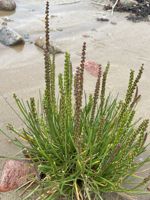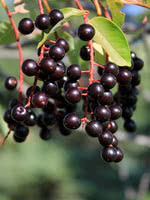Mon-Fri 9am - 5pm Mountain time
Western Chokecherry vs Seaside Arrowgrass
Triglochin maritima
Prunus virginiana var. demissa
CUSTOM GROW
SOLD OUT
Seaside Arrowgrass is a native perennial commonly found in wetlands, salt marshes, and moist meadows. It is especially suitable for difficult growing sites. Its dense root system helps stabilize soil, while also providing food, cover, and habitat for small animals within the wetland community.
Seaside Arrowgrass is suitable for shoreline stabilization, wetland restoration, and naturalization projects.
Western Chokecherry is a shrub or small tree commonly used for farmstead and field windbreaks.
It produces white flowers in the spring and edible dark purple fruit that matures between September and October. Its cherries are great for making for making jams, jellies or wine, but are not very palatable for raw eating.

